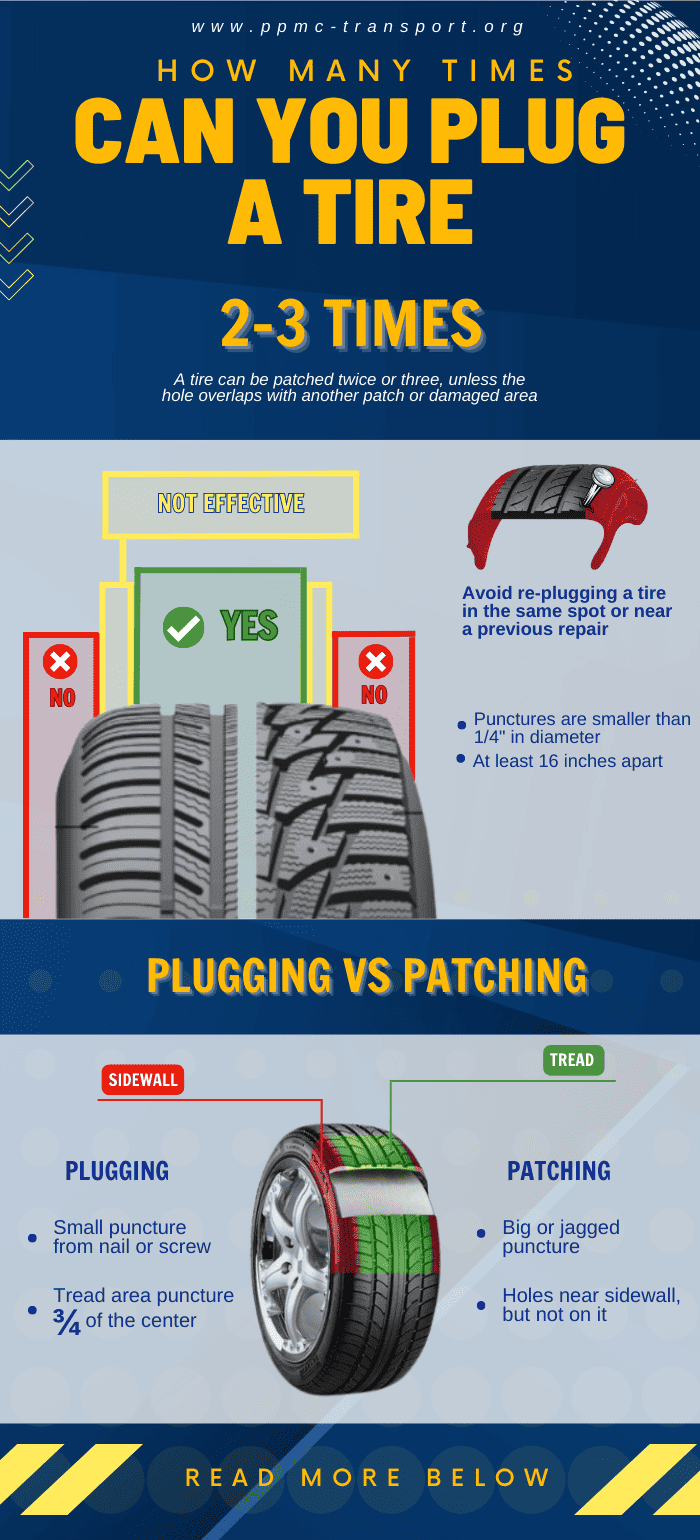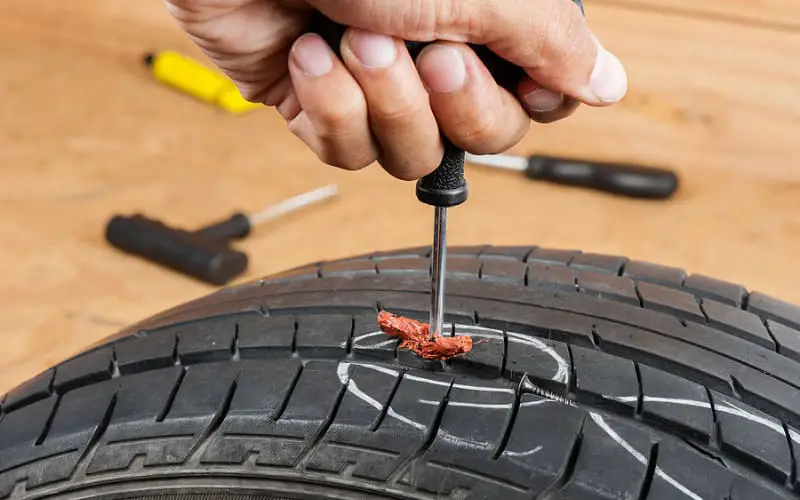Intro-
Picture this: you’re cruising down the road on a sunny day. You are enjoying the breeze, when suddenly you hear a dreaded hissing sound. Yep, it’s a flat tire. But don’t worry, because today we’re going to tackle a question that might have crossed your mind: “How many times can you patch a tire?” Well, my friend, let’s dive in and find out!
Ah, the trusty tire patch. It’s like a superhero that swoops in to save the day when your tire meets a pesky nail or a sharp object on the road. But just like any superhero, there are limits to its powers and depends on certain factors.
First off, it’s important to consider the location of the puncture. If the hole is in the tread area (the part that touches the road), it’s usually safe to patch it. However, if the damage is near the sidewall or shoulder, patching might not be the best option. So, the location plays a crucial role in determining how many times you can patch a tire.
Now that we’ve covered the basics, let’s buckle up and dig deeper into the factors that affect the number of times you can patch a tire. Remember, my young road warrior, safety always comes first! So, join me on this adventurous journey of tire patching knowledge.
When it comes to patching a tire, it’s important to remember it’s a temporary fix. The number of times you can patch a tire depends on several factors, such as the size of the puncture, the location on the tire, and the age of the tire. In general, experts recommend patching a tire no more than three times. After that, it’s safer to replace the tire altogether to ensure your safety on the road.

Source: ppmc-transport.org
How Many Times Can You Patch a Tire: Exploring the Limits
When it comes to tire repairs, one question that often arises is- how many times can you patch a tire before it becomes unsafe or ineffective? The answer to this may vary depending on various factors. This includes the size and location of the damage, the type of tire, and the recommendations of tire manufacturers.
Understanding Tire Patching and Its Limitations
To grasp the frequency of tire patching, it’s vital to comprehend the tire patching process and its constraints. When a tire experiences damage like a puncture or minor tear, a patch or plug usually seals the hole and restores tire functionality. Remember that tire patches are not designed for a lasting fix. Over time, the effectiveness of the patch may diminish, leading to potential safety concerns.
The maximum number of times a tire can be patched depends on several factors. These factors include- the size of damage, the location of puncture, the type of tire, and recommendations provided by tire manufacturers. It’s important to consult with a tire professional or refer to the manufacturer’s guidelines to determine the specific limitations of your tire.
While it may be tempting to continuously patch a tire to save money, it’s essential to prioritize safety. Continuing to patch a tire beyond its recommended limit can compromise its integrity. It can also increase the risk of a blowout or loss of control while driving. It’s crucial to monitor the condition of your tire and replace it if it exceeds the recommended number of patch repairs.
The Factors that Determine the Number of Times a Tire Can Be Patched
Several factors come into play when determining how many times a tire can be patched. Let’s take a closer look at each of these factors:
- Size of the Damage: The number of times a tire can be patched is heavily influenced by the size of the damage. Smaller punctures or tears can frequently undergo multiple safe repairs, whereas larger damages might necessitate replacement instead.
- Location of the Puncture: The location of the puncture also impacts the longevity of a tire patch. Punctures closer to the sidewall or shoulder of the tire tend to be more challenging to repair and may reduce the number of patching opportunities.
- Type of Tire: Different types of tires have varying capabilities when it comes to patch repairs. Performance tires, for example, may have more stringent limitations compared to standard passenger car tires.
- Tire Manufacturer’s Recommendations: The recommendations provided by tire manufacturers are crucial in determining the safe number of tire patch repairs. These guidelines are often based on extensive testing and research, ensuring the safety and performance of the repaired tire.
Consider these factors as it is important to follow the guidelines set forth by the tire manufacturer. To ascertain the maximum allowable number of tire patches, seek guidance from a tire professional.
The Importance of Regular Inspections and Proper Maintenance
To ensure the longevity and safety of your tires, regular inspections and proper maintenance are essential. Here are some tips to keep in mind:
- Inspect your tires regularly for signs of damage or wear. Look for any punctures, bulges, or uneven tread wear.
- Maintain proper tire inflation to optimize handling, fuel efficiency, and tread life.
- Rotate your tires regularly to promote even wear and extend their overall lifespan.
- Avoid driving over rough terrain or debris that could potentially damage your tires.
- When in doubt, consult with a tire professional for expert advice and guidance.
By following these maintenance practices and being proactive in identifying and addressing tire issues, you can extend the life of your tires and ensure a safer driving experience.
Tire Patching: A Safe and Cost-Effective Solution When Done Right
Tire patching can be a reliable and cost-effective solution when done correctly and within the recommended guidelines. By understanding the limitations of tire patching and following proper maintenance practices, you can safely extend the life of your tires and avoid potential risks on the road. Remember, always prioritize safety and consult with professionals when in doubt. Happy and safe travels!
Key Takeaways: How Many Times Can You Patch a Tire?
- Patching a tire can be done multiple times, but it is generally recommended to only patch a tire once.
- The number of times a tire can be patched depends on the size and location of the puncture. The tir’s overall condition also acts as a factor.
- Patching a tire more than once can compromise its structural integrity and increase the risk of a blowout.
- It is essential to have a professional tire technician assess the damage. A professional can determine if patching is safe or if tire replacement is necessary.
- Maintaining proper tire care and preventing punctures is the best way to avoid the need for repeated patching.
Frequently Asked Questions
Tires are an essential part of a vehicle’s safety and performance. One common question that arises is how many times a tire can be patched. Let’s explore the answer to this question and more in the following FAQs.
1. Can you patch a tire more than once?
Under certain conditions, it’s possible to patch a tire more than once. Keep in mind that the number of patches a tire can receive depends on factors. These include- the size and location of the damage, the tire’s age and condition, and the manufacturer’s recommendations. It is always best to consult a professional tire technician to assess the damage and determine if it is safe to patch the tire again.
Remember that patching a tire can compromise its structural integrity to some degree. Excessive patching raises the potential for a blowout or loss of control, posing a safety risk. Hence, experts usually advise replacing a severely damaged tire rather than repeatedly patching it.
2. How can I determine if a tire is patchable?
When it comes to determining if a tire is patchable, it is crucial to consider the guidelines set forth by the Rubber Manufacturers Association (RMA) and the tire manufacturer. Generally, a tire can be patched if the puncture is within the repairable zone. This is the tread area and does not extend to the sidewall. The damage should also be within a specific size limit. It should not be larger than 1/4 inch in diameter for passenger car tires.
Additionally, the tire should not have previous repairs in the same location, as this can compromise the tire’s integrity.
The evaluation of damage and the decision on whether the tire can be patched or needs replacement are crucial tasks that require the expertise of a professional tire technician.
3. Are there any circumstances where a tire cannot be patched?
Yes, there are circumstances where a tire cannot be patched and must be replaced instead. Some common scenarios include:
– If the damage is on the sidewall or shoulder of the tire: These areas are not suitable for repair, as they endure a lot of stress and can lead to a blowout if patched.
-If the damage exceeds the recommended size limit or severely compromises the tire, replacement may be necessary instead of patching.
-When the tire has undergone previous repairs in the same area, multiple repairs can weaken its integrity. This increases the risk of failure.
Remember, these are general guidelines, and it is always best to consult with a professional tire technician.
4. Can I patch a run-flat tire?
Run-flat tires have a specific design that enables a vehicle to continue driving for a certain distance at reduced speeds following a puncture. However, repairing run-flat tires can be challenging due to their reinforced sidewalls. In numerous cases, run-flat tires might necessitate replacement, even if the damage falls within the repairable zone.
To determine if a run-flat tire can undergo repair, it’s crucial to adhere to the tire manufacturer’s guidelines. Consult with a tire technician who possesses professional expertise. They will evaluate the damage and consider the tire’s construction. They will also take into account the specific repair methods recommended by the manufacturer.
5. Can I patch a tire myself?
Patching a tire is a complex task that requires expertise and specialized tools. Leave tire repairs to professionals. Tire technicians have the knowledge and experience to properly assess the damage, determine if patching is safe, and execute the repair correctly.
Improperly patched tires can lead to serious safety risks, including tire failure while driving. Consult a professional tire technician. He will ensure correct repair execution and offer reassurance about the safety of your tires on the road.

Source: tireer.com
Tire puncture – Patch it, or plug it? | Fix them the right way
Summary
So, how many times can you patch a tire? Well, it depends on a few factors.
First, the size and location of the puncture matter. You can patch small holes in the tread for a few times. But if the puncture is too big or in the sidewall, it’s best to replace the tire.
Second, the age and condition of the tire play a role. An old tire with worn-out tread may not be safe to patch.
Ultimately, it’s always best to consult a professional tire technician. Someone who can assess the situation and give you the best advice for your specific tire. Remember, safety should always be the top priority when it comes to tires.
